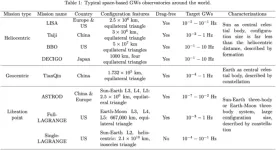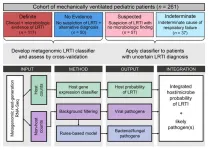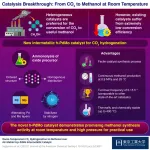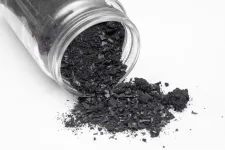(Press-News.org) About The Study: This study found that historical redlining was associated with modern-day stroke prevalence in New York City independently of contemporary social determinants of health and community prevalence of some relevant cardiovascular risk factors.
Authors: Benjamin M. Jadow, B.A., of the Albert Einstein College of Medicine in Bronx, New York, is the corresponding author.
To access the embargoed study: Visit our For The Media website at this link https://media.jamanetwork.com/
(doi:10.1001/jamanetworkopen.2023.5875)
Editor’s Note: Please see the article for additional information, including other authors, author contributions and affiliations, conflict of interest and financial disclosures, and funding and support.
# # #
Embed this link to provide your readers free access to the full-text article This link will be live at the embargo time http://jamanetwork.com/journals/jamanetworkopen/fullarticle/10.1001/jamanetworkopen.2023.5875?utm_source=For_The_Media&utm_medium=referral&utm_campaign=ftm_links&utm_term=040523
About JAMA Network Open: JAMA Network Open is an online-only open access general medical journal from the JAMA Network. On weekdays, the journal publishes peer-reviewed clinical research and commentary in more than 40 medical and health subject areas. Every article is free online from the day of publication.
END
Historical redlining, social determinants of health, and stroke prevalence in communities in New York City
JAMA Network Open
2023-04-05
ELSE PRESS RELEASES FROM THIS DATE:
The unexpected contribution of medieval monks to volcanology
2023-04-05
By observing the night sky, medieval monks unwittingly recorded some of history’s largest volcanic eruptions. An international team of researchers, led by the University of Geneva (UNIGE), drew on readings of 12th and 13th century European and Middle Eastern chronicles, along with ice core and tree ring data, to accurately date some of the biggest volcanic eruptions the world has ever seen. Their results, reported in the journal Nature, uncover new information about one of the most volcanically active periods in Earth’s ...
Is artificial intelligence better at assessing heart health?
2023-04-05
Who can assess and diagnose cardiac function best after reading an echocardiogram: artificial intelligence (AI) or a sonographer?
According to Cedars-Sinai investigators and their research published today in the peer-reviewed journal Nature, AI proved superior in assessing and diagnosing cardiac function when compared with echocardiogram assessments made by sonographers.
The findings are based on a first-of-its-kind, blinded, randomized clinical trial of AI in cardiology led by investigators in the Smidt Heart Institute and the Division of Artificial Intelligence in Medicine at Cedars-Sinai.
“The results have immediate implications for ...
Gwangju Institute of Science and Technology researchers correlate Arctic warming to extreme winter weather in midlatitude and its future
2023-04-05
Pictures of melting glaciers and stranded polar bears on shrinking sea ice in the Arctic are perhaps the most striking images that have been used to highlights the effects of global warming. However, they do not convey the full extent of the consequences of warmer Arctic. In recent years, there has been growing recognition of the Arctic’s role in driving extreme weather events in other parts of the world. While the Arctic has been warming at a rate twice as fast as the global average, winters in the midlatitude regions have experienced colder and more severe weather events. For instance, the winter of 2022-2023 saw record-breaking cold temperatures and snowfall ...
Finding a way to combat long COVID
2023-04-05
A new study has identified potential neurological biomarkers of long COVID-19 in nonhuman primates that may help physicians diagnose, monitor and treat this condition.
Over 65 million people worldwide have developed long COVID after being infected with SARS-CoV-2, and cases are only becoming more common. Long COVID symptoms can last weeks, months or years. Even more perplexing is the fact that symptoms can vary widely between individuals and consist of any combination of fatigue, fever, chest pain, trouble breathing, neurological symptoms such as ...
Overview of orbital mechanics for space-based gravitational wave observatories
2023-04-05
Gravitational waves (GWs) are “ripples in space-time”. The detection of gravitational waves (GWs) is critical to the understanding of the origin and evolution of stars, galaxies, and the Universe. At present, the laser interferometry is the most commonly use technology to detect GWs by measuring the phase change between two beams of coherent light. Due to the limitations of arm length, the ground-based GWs measurement is hard to detect the low-frequency GWs. While the space-based GWs observation is capable of longer arm length of the interferometer, the detection of GWs in space is expected to cover a greater number and variety of ...
Cracking the puzzle of lower respiratory tract infections in children
2023-04-05
Lower respiratory tract infection (LRTI), which includes conditions such as pneumonia, has long been the leading cause of death from communicable agents and a leading cause of death in children worldwide. But despite its prevalence, LRTI is tricky for doctors to treat effectively because the current diagnostic approach often fails to conclusively determine whether an infection is present at all, and if so, what pathogen is causing it.
Now, in a study published April 3, 2023 in The Journal of Clinical Investigation, a team led by researchers at the Chan Zuckerberg Biohub San Francisco (CZ Biohub SF), UC San Francisco (UCSF), the University ...
Opening a new frontier: PdMo intermetallic catalyst for promoting CO2 utilization
2023-04-05
Being the most abundant and persistent greenhouse gas emitted, carbon dioxide (CO2) is the key driver of climate change. To address the pressing problems associated with climate change and fossil fuel depletion, scientists are looking for viable solutions that can minimize the amount of CO2 released into the atmosphere. One attractive solution to this problem is to convert atmospheric CO2 into more useful compounds. Towards this end, methanol - a raw material, fuel additive, and energy carrier, is widely being explored as a promising conversion option for CO2.
Now, while various catalysts ...
SwRI, Tec de Monterrey award funding for sustainable manufacturing research
2023-04-05
SAN ANTONIO — April 5, 2023 —Southwest Research Institute and Tecnológico de Monterrey (Tec de Monterrey) will jointly fund three research and development initiatives to advance sustainable manufacturing and technology in the United States and Mexico. The trio of projects are the first selected to receive support through the Sustainable Manufacturing Program, a transnational research and development collaboration established between SwRI and Tec de Monterrey — a private, nonprofit, independent university based in Monterrey, Mexico — in August 2022. The program provides grant opportunities funded ...
How were amino acids, one of the key building blocks of life, formed before the origin of life on Earth? Tiny particles from the near Earth asteroid Ryugu can help answer this profound question
2023-04-05
Our solar system formed from a molecular cloud, which was composed of gas and dust that was emitted into the interstellar medium (ISM), a vast space between stars. On collapse of the molecular cloud, the early sun was formed, with a large disk of gas and dust orbiting it. The dusty material collided to produce rocky material that would eventually grow in size to give large bodies called planetesimals.
The planetesimals that formed far enough from the sun, also contained large quantities of ice. The ice consisted of water and other volatile compounds, such as carbon monoxide (CO), carbon dioxide (CO2), methanol (CH3OH) and ammonia (NH3), as well as ...
Air pollution is linked to lower COVID-19 vaccine responses
2023-04-05
People exposed to higher levels of air pollution before the pandemic had lower antibody responses to COVID-19 vaccines, according to a study led by the Barcelona Institute for Global Health (ISGlobal), an institution supported by “la Caixa” Foundation, in collaboration with the Germans Trias i Pujol Research Institute (IGTP). In particular, exposure to fine particulate matter (PM2.5), nitrogen dioxide (NO2) and blank carbon (BC) was associated with about a 10% decrease in IgM and IgG antibody responses in people without prior infection. The findings, published in Environmental Health Perspectives, ...
LAST 30 PRESS RELEASES:
The perfect plastic? Plant-based, fully saltwater degradable, zero microplastics
Bias in data may be blocking AI’s potential to combat antibiotic resistance
Article-level metrics would provide more recognition to most researchers than journal-level metrics
Satiety’s little helper: Protein that supports appetite regulating protein identified
UF dives deep into predicting storm damage with computer models
A stormy ocean voyage yields insights on the global carbon cycle
Scientists identify first non-coding gene that controls cell size
Demonstration of altermagnetism in RuO₂ thin films -- A new magnetic material for the AI era
Penn researchers awarded $25M to conduct trial using smartphones to fight heart disease
PCORI awards funding for new patient-centered healthcare research
Exploring the origins of the universe: 145 low-noise amplifiers complete ALMA telescopes
Empress cicada wings help illuminate molecular structure
Using sound waves to detect helium
Time burden in patients with metastatic breast and ovarian cancer from clinic and home demands
Researchers discover bias in AI models that analyze pathology samples
Scientists ID potential way to prevent brain injuries from triggering Alzheimer's
MASTER 2nd Open Call: Execution period kick-off
Algae for health in food and pharma
Advanced microrobots driven by acoustic and magnetic fields for biomedical applications
Chicago health information leader recognized for raising CPR readiness and blood pressure awareness
The Intimate Animal, a new book from Kinsey Institute Executive Director Dr. Justin Garcia
When blue-collar workers lose union protection, they try self-employment
New video dataset to advance AI for health care
MEA-based graph deviation network for early autism syndrome signatures in human forebrain organoids
New modeling approach sheds light on rare gut disease
Study documents potentially hazardous flame retardants in firefighter gear
Can certain bacteria regulate aging of the immune system and its related alterations?
AI model helps diagnose often undetected heart disease from simple EKG
There are fewer online trolls than people think
Cell membrane fluctuations produce electricity
[Press-News.org] Historical redlining, social determinants of health, and stroke prevalence in communities in New York CityJAMA Network Open





